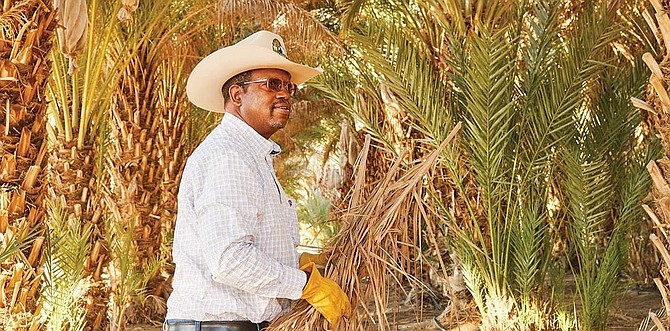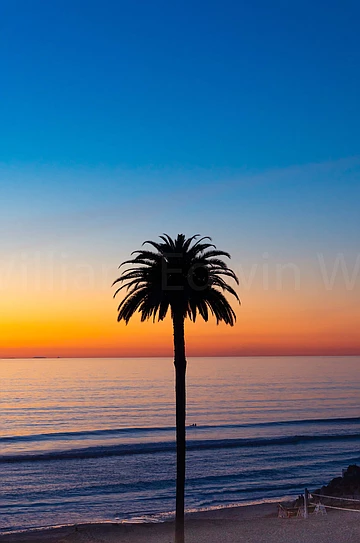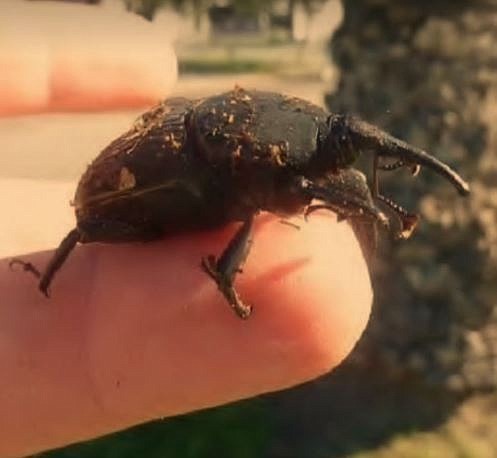 Facebook
Facebook
 X
X
 Instagram
Instagram
 TikTok
TikTok
 Youtube
Youtube

Flat top palm trees aren't a new species; they're the leftovers of a non-native weevil feeding frenzy. And they're all over Encinitas.
The scraggly remnants of once-lush Canary Island date palms are the visible signs that the South American palm weevil, a non-native "snout beetle," has fully landed. It has been chomping its way north, preferring date palms but happy to settle for avocado and citrus,

"It's one of the ugliest bugs I've ever seen in my life. They walk in a way that really intimidates me a lot," said mayor Tony Kranz last week, when the city council discussed their counter attack. "Their back end is up high," he added. "And they move very slowly. It looks like a little robot."
Since the weevil was first detected in San Ysidro in 2011, it has left a body count of about 20,000 trees. Encinitas has been particularly hard hit. In January 2023, the city had 280 Canary Island date palms in the public right-of-way. After dozens were removed due to infestation, it's down to 236.
Mission Bay is another battleground. Inland, the Coachella Valley is home to a thriving date palm industry. And fruit growers throughout southern California are keeping tabs on the bug's spread.
A consultant for Encinitas came up with three possible treatment options. The first involved no chemicals — an approach favored by many locals — and removal of infested palms. The second, treating every Canary Island date palm, would result in the lowest tree mortality. Applied to the crown, the chemical coats the tissue the pest attacks and kills the bug.

The city settled on option three; treating only palms identified as heritage trees. Of which the city has just one; the postcard palm that casts its tropical sliver of shade over Moonlight Beach.
For each option, pruning the trees from November through April — the overwintering period of the weevil- was recommended during dry weather, when tree mortality is highest.
Chemical treatment is a last resort for bee cities like Encinitas that enjoy healthy bee populations, as the chemical is highly toxic to the pollinators. Treatment occurs four times per year, and overlaps many blooming season plants, city staff said.
Biological control, a method that uses a pest's natural enemies like predators, parasites, and pathogens, is years away in development, said arborist Katrina Burritt, who has worked in the field in San Diego since the infestation began.
Council members suggested turning away from non native species wherever possible to encourage more natural pest resistance. The city's only native palm, Washingtonia filifera, is less susceptible to infestation, but most palm species are considered at risk. So far the others haven't been a target.
For now, palms can only be treated with chemicals if the city wants to save them, Burritt said.
Controlling the weevil population won't be that simple, though. The city counts public trees, but has no idea how many are on private property.
"We could guess that there are a lot more privately owned than public," said councilmember Bruce Ehlers. "So if we treat our 1/4 [or however many are in the public right-of-way], "there's still a whole bunch of bugs" munching their way through the trees. "We're not gonna control this through our actions — and we don't have the ability to make private people do it, either."
According to Burritt, as the Canary Island palm population dwindles, the threat will shift to other trees, from palms to avocados and citrus.
"They will hit the Phoenix canariensis first and as the population declines they will start moving on to other species."


Flat top palm trees aren't a new species; they're the leftovers of a non-native weevil feeding frenzy. And they're all over Encinitas.
The scraggly remnants of once-lush Canary Island date palms are the visible signs that the South American palm weevil, a non-native "snout beetle," has fully landed. It has been chomping its way north, preferring date palms but happy to settle for avocado and citrus,

"It's one of the ugliest bugs I've ever seen in my life. They walk in a way that really intimidates me a lot," said mayor Tony Kranz last week, when the city council discussed their counter attack. "Their back end is up high," he added. "And they move very slowly. It looks like a little robot."
Since the weevil was first detected in San Ysidro in 2011, it has left a body count of about 20,000 trees. Encinitas has been particularly hard hit. In January 2023, the city had 280 Canary Island date palms in the public right-of-way. After dozens were removed due to infestation, it's down to 236.
Mission Bay is another battleground. Inland, the Coachella Valley is home to a thriving date palm industry. And fruit growers throughout southern California are keeping tabs on the bug's spread.
A consultant for Encinitas came up with three possible treatment options. The first involved no chemicals — an approach favored by many locals — and removal of infested palms. The second, treating every Canary Island date palm, would result in the lowest tree mortality. Applied to the crown, the chemical coats the tissue the pest attacks and kills the bug.

The city settled on option three; treating only palms identified as heritage trees. Of which the city has just one; the postcard palm that casts its tropical sliver of shade over Moonlight Beach.
For each option, pruning the trees from November through April — the overwintering period of the weevil- was recommended during dry weather, when tree mortality is highest.
Chemical treatment is a last resort for bee cities like Encinitas that enjoy healthy bee populations, as the chemical is highly toxic to the pollinators. Treatment occurs four times per year, and overlaps many blooming season plants, city staff said.
Biological control, a method that uses a pest's natural enemies like predators, parasites, and pathogens, is years away in development, said arborist Katrina Burritt, who has worked in the field in San Diego since the infestation began.
Council members suggested turning away from non native species wherever possible to encourage more natural pest resistance. The city's only native palm, Washingtonia filifera, is less susceptible to infestation, but most palm species are considered at risk. So far the others haven't been a target.
For now, palms can only be treated with chemicals if the city wants to save them, Burritt said.
Controlling the weevil population won't be that simple, though. The city counts public trees, but has no idea how many are on private property.
"We could guess that there are a lot more privately owned than public," said councilmember Bruce Ehlers. "So if we treat our 1/4 [or however many are in the public right-of-way], "there's still a whole bunch of bugs" munching their way through the trees. "We're not gonna control this through our actions — and we don't have the ability to make private people do it, either."
According to Burritt, as the Canary Island palm population dwindles, the threat will shift to other trees, from palms to avocados and citrus.
"They will hit the Phoenix canariensis first and as the population declines they will start moving on to other species."
Comments